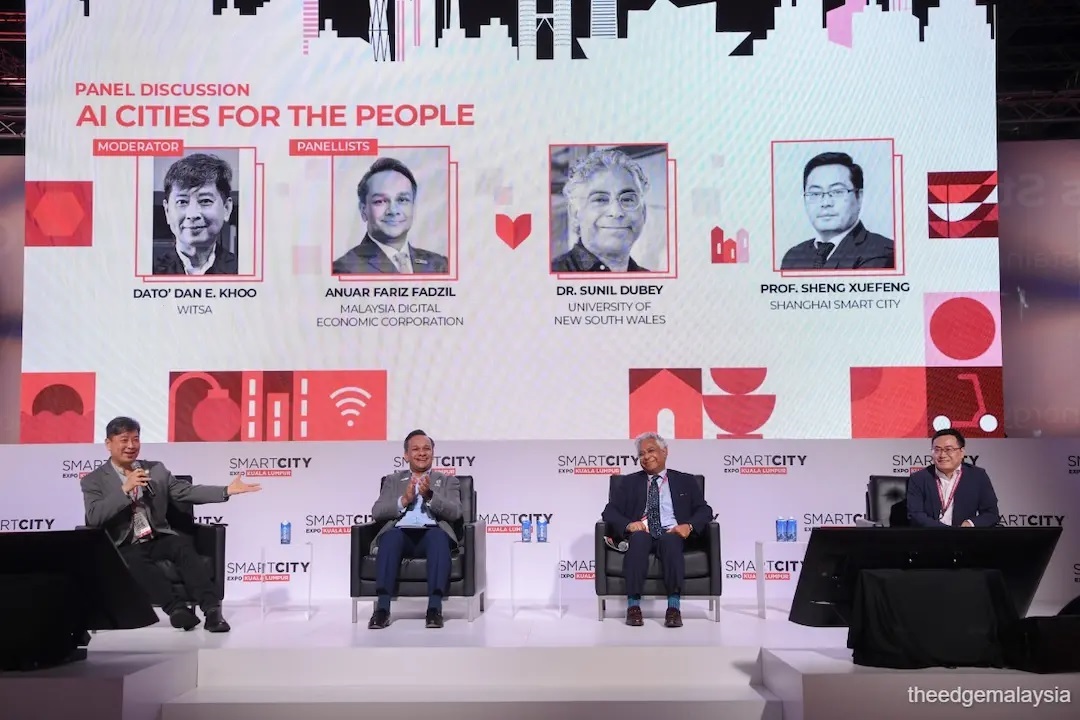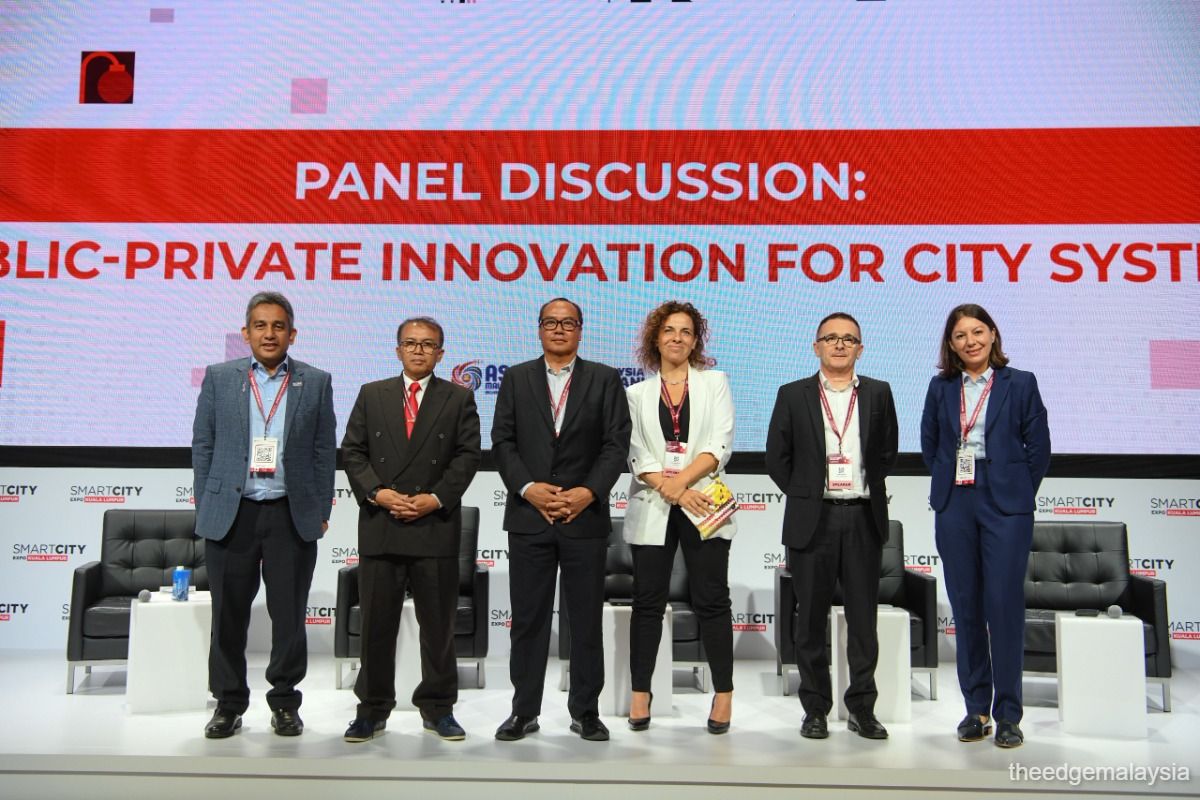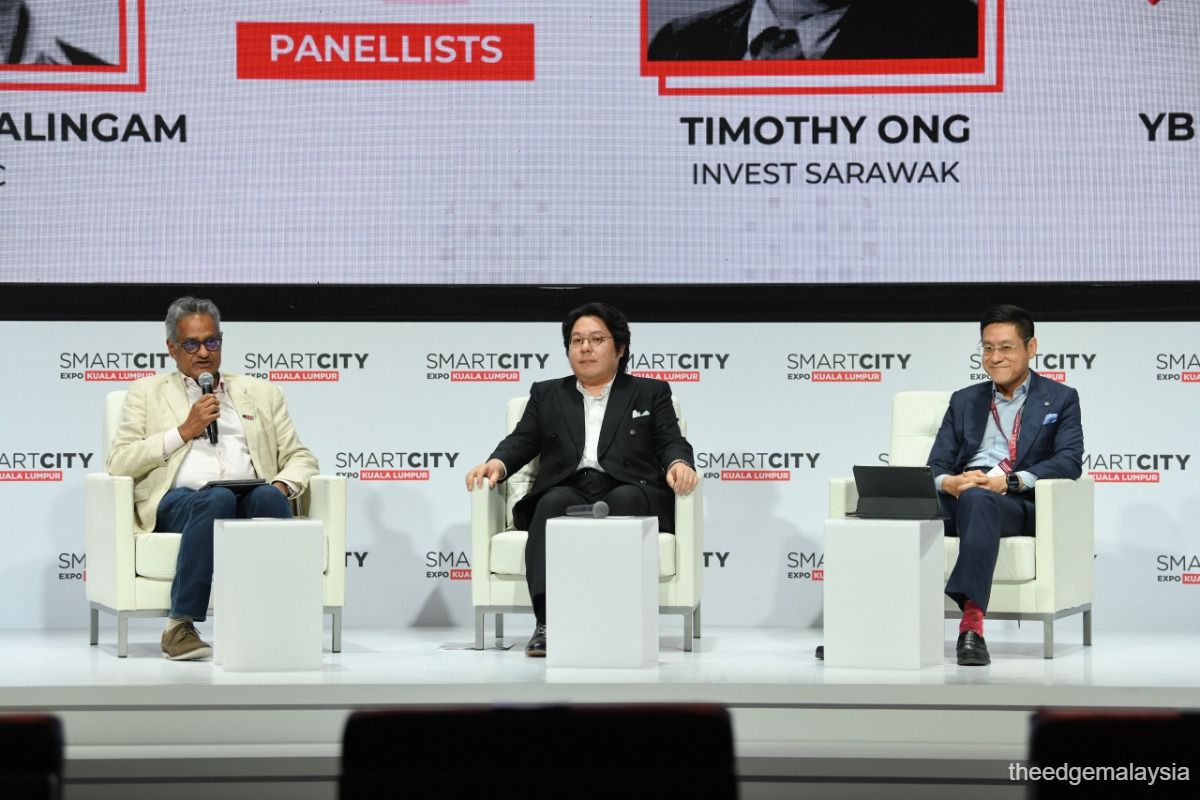
- MDEC is working closely with the federal government on three smart city projects: creating Digital Twins to predict traffic and flood risks, Smart Tree profiling and Digital Avatars to improve city planning.
KUALA LUMPUR (Sept 19): Malaysia is stepping up its push to develop artificial intelligence-enabled (AI) cities, positioning technology as a driver of productivity, efficiency and sustainability. At the Smart City Expo KL, Malaysia Digital Economy Corporation (MDEC) CEO Anuar Fariz Fadzil said the agency is working closely with city councils to embed AI-enabled digital tools into urban systems.
“We are driving digital adoption, we're driving how [Malaysia] embraces technology. But on a bigger scale, we work with the city councils on how we can make technology an enabler for Malaysia to be more productive and greener,” he said during the panel session “AI cities for the people” at the Kuala Lumpur Convention Centre.
Currently, MDEC is working closely with the federal government on three smart city projects: creating Digital Twins to predict traffic and flood risks, Smart Tree profiling and Digital Avatars to improve city planning.
In the panel, Malaysia’s speed in its adoption of new technology throughout its cities was complemented by the other speakers, which Anuar said is due to the country’s ability to learn from pioneers.
“For us, we were lucky that we can learn from our neighbours, our peers and globally. So, we don't have to replicate their mistakes, we can follow the best practices,” said Anuar. Sheng Xuefeng, president of the Shanghai Smart City Development Institute, highlighted how AI cities have similarly enhanced the lives of their citizens since their adoption, especially towards its senior citizens, who make up 40% of the city’s population.
“A lot of older people means that they need a lot of government services from different sectors, from different departments. In the traditional ways, they make the older citizens fill out application forms on the website [or in person]. Now, using AI technology, older people never need to fill out another form, online or offline. They will get the subsidies directly,” said Sheng. He added that the government is using AI technology to not only increase efficiency and convenience for its people, but also increase transparency.
Assistant professor and city strategy lead at the University of New South Wales Cities Institute Sunil Dubey pointed out that while the technology for AI cities holds a lot of promise, the rapid speed of its development poses a risk as governance and laws struggle to catch up. Sunil said that, in response, the state of New South Wales had only just recently established Australia’s first government agency to talk about the moral, ethics and governance of AI in cities, the Office for Artificial Intelligence.
He stressed the importance of this due to the rising penetration of AI adoption in city systems, which still use old governance frameworks.
Data governance is key for smart city investments
On related note, Stéphane Péan, consultant at Ker-Iz Consulting said that for smart cities in Asean to attract investments, the region will need to build an interconnected urban ecosystem through a clean and robust data governance framework.
Péan, who has experience governments on sustainable urban development and mobility, said that this can be developed through integrated public policies and interoperable infrastructures for data sharing, connectivity between different systems and setting the foundation for proper data governance.

In Europe, there have been different regulatory frameworks introduced, such as the Data Act, where it is mandatory for Internet-of-Things (IoT) companies to ask citizens for consent in collecting data to build new integrated policies.
He also shared that Europe Union (EU) made progress in this area in December last year by setting a dedicated body to focus on public procurement of cities on the continent and foster the idea of interoperable formats to create a single market for smart cities.
“Without data, you cannot monitor what you are doing, you cannot assess anything. So, it's crucial to start with a new organisation as there is no one-size-fits-all [structure]. Malaysia is not France, Asean is not EU, so it should be a bottom-up approach instead of a top-down approach,” he said in the panel session titled “Public-private innovation for city systems”.
Géraldine Andrieux, founder and CEO of innovation strategy firm Blumorpho, said that data will be important in powering technologies like AI to address complexities in business models and foster an ecosystem that attracts private investors.
Public investments alone are not enough to develop smart cities due to the scale and size that is required for each land area, and with AI, can enable a vision to guide smart city growth, whilst finding solutions that best benefit its citizens.
Farjola Peco, head of strategy at Ericsson Southeast Asia, Oceania and India, added that while having a proper digital and AI infrastructure plays a crucial role in supporting the development of smart cities, authorities must identify the pressing challenges of a city to employ the proper technology to solve the issue.
“Bottom line is, you really need to be able to have the right infrastructure to solve the right problem for the right challenge. We know AI is the answer, but what is the problem that we're actually trying to solve? It really needs to be supported by an interoperability of the systems, and I think that's why it makes integration rather complex,” said Peco. Investable projects locally Malaysia has several urban projects in the pipeline to attract investments and support the infrastructure for smart city development.
Zairil Khir Johari, executive council member of Penang, said that island state has recently reclaimed an island plot of 2,300 acres to be called Silicon Island to address the issue of land scarcity, particularly in industrial land, as well as fostering job creation. This development will be a natural extension near the Penang airport, Penang bridge and the Bayan Lepas Free Industrial Zone, and the design of the island will be ESG-compliant along its developmental journey.

“We already have about 230 over acres reclaimed. We foresee the first factory to be built there in 2027. The LRT depot will be on Silicon Island, as we already have half of the land ready for them for MRT Corporation. So work is going on very quickly and we are trying to speed it up even more to get this ready in time.
“The whole 2,300 acres will take a longer time by another 10 years to fully complete, but we're doing it in phases... This presents great opportunities, not just in the industrial side of things, but also in residential and commercial developments,” said Zairil in the panel session titled ‘Investable projects and opportunities’.
Timothy Ong, CEO of Invest Sarawak, said that Sarawak sees a lot of attractive investment in extracting the potential of its renewable energy sources.
“The upside is that we have not even scratched the surface in terms of the renewable energy potential. We’re talking about [a generation of] 3.7 gigawatts to a potential of 20 gigawatts just from hydro sources alone,” he said.
Sarawak is also looking to introduce a 70km stretch of an autonomous rapid transit system starting from Kuching and extending across different cities in Sarawak. One hundred hydrogen-powered feeder buses will be deployed to support the operation through first and last-mile transport. Additionally, both Penang and Sarawak are tackling the challenge of talent retention through their own means.
Zairil added that Penang takes the approach of inculcating interest in science and technology in young students starting from primary schools. He shared that the recent enrolment of students in science streams has decreased from a third to a quarter of the population, and the goal will be to renew this interest within the upcoming generation.
Meanwhile, Ong shared that Sarawak’s plan to foster talent in the state is through the decision to provide free education up to the tertiary level. Government-owned universities and six private Institutions, including Curtin University, Swinburne University and University Technology Sarawak will be free of charge for all Sarawakians.
As Penang girds itself towards the last lap of its Penang2030 vision, check out how the residential segment is keeping pace in EdgeProp’s special report: PENANG Investing Towards 2030.





